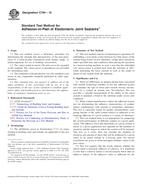Potrebujeme váš súhlas na využitie jednotlivých dát, aby sa vám okrem iného mohli ukazovať informácie týkajúce sa vašich záujmov. Súhlas udelíte kliknutím na tlačidlo „OK“.
ASTM C794-10
Standard Test Method for Adhesion-in-Peel of Elastomeric Joint Sealants
Automaticky preložený názov:
Štandardná skúšobná metóda pre lepenie-in-Peel elastomerových tesniacich
NORMA vydaná dňa 1.9.2010
Informácie o norme:
Označenie normy: ASTM C794-10
Poznámka: NEPLATNÁ
Dátum vydania normy: 1.9.2010
Kód tovaru: NS-15096
Počet strán: 7
Približná hmotnosť: 21 g (0.05 libier)
Krajina: Americká technická norma
Kategória: Technické normy ASTM
Anotácia textu normy ASTM C794-10 :
Keywords:
adhesion-in-peel, elastomeric joint sealant, water immersion, Peel strength tests, Adhesion-in-peel, Joint seals/sealants, ICS Number Code 83.060 (Rubber), 91.100.50 (Binders. Sealing materials)
Doplňujúce informácie
| Significance and Use | ||||||||
|
There are differences in opinion among those concerned with sealant technology whether or not this adhesion-in-peel test simulates the type of strain and e-tensile stresses encountered by a sealant in normal use. Nevertheless, this test provides a valuable measurement of the ability of the cured sealant to maintain a bond to the substrate under severe peel conditions. Many sealant manufacturers utilize the adhesion-in-peel test for determining the adhesive characteristics of sealant/primer combinations with unusual or proprietary substrates. This test is especially useful for quality measurements comparing batches of the same sealant relative to adhesion or for studying adhesion of a given sealant to a variety of substrates. This test method alone is not appropriate for comparing the overall performance of different sealants in a given application. The adhesive force that determines if a given sealant is useful in a given application also depends on the modulus of elasticity and the degree to which the sealant will be strained. This test, as it exists, does not consider the modulus of elasticity, nor amount of stress that will be produced by a given strain in an actual sealant in a moving joint. No known correlations are given to relate and apply modulus values to the peel values. This test requires that the results indicate whether the failure mode is primarily adhesive or cohesive. It is important to note that a cohesive failure is not necessarily better than an adhesive failure, if the adhesive value is sufficient for the application. Having adhesive failure allows one to study the change of adhesion with time and with the various stress conditions. |
||||||||
| 1. Scope | ||||||||
|
1.1 This test method covers a laboratory procedure for determining the strength and characteristics of the peel properties of a cured-in-place elastomeric joint sealant, single- or multicomponent, for use in building construction. 1.2 The values stated in metric (SI) units are to be regarded as the standard. The values given in parentheses are provided for information only. 1.3 The committee with jurisdiction over this standard is not aware of any comparable standards published by other organizations. 1.4 This standard does not purport to address all of the safety problems, if any, associated with its use. It is the responsibility of the user of this standard to establish appropriate safety and health practices and determine the applicability of regulatory limitations prior to use. |
||||||||
| 2. Referenced Documents | ||||||||
|




 Cookies
Cookies
